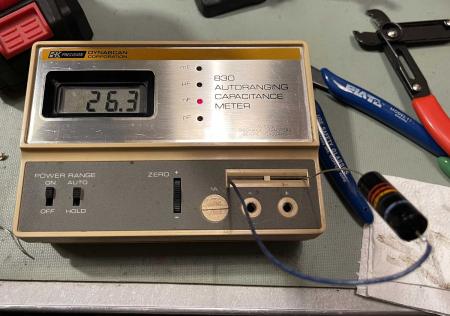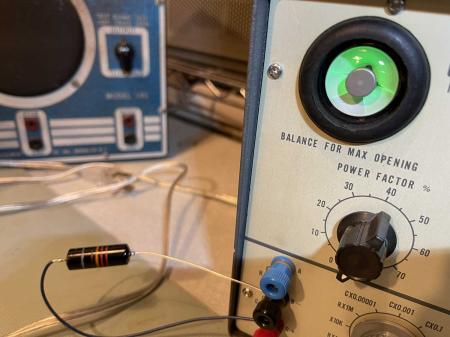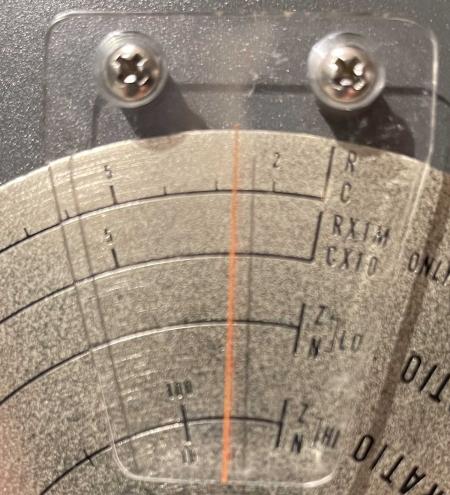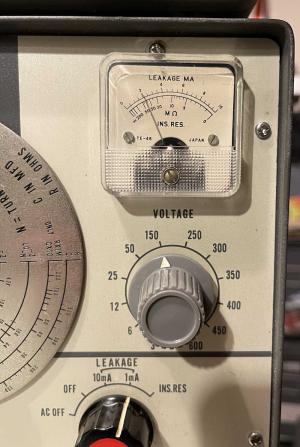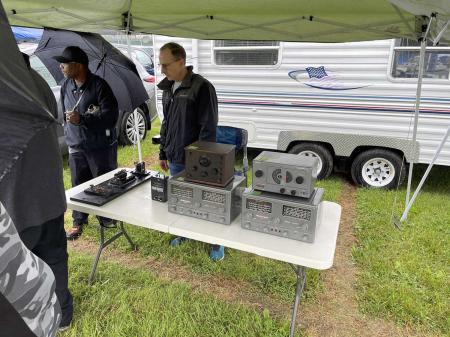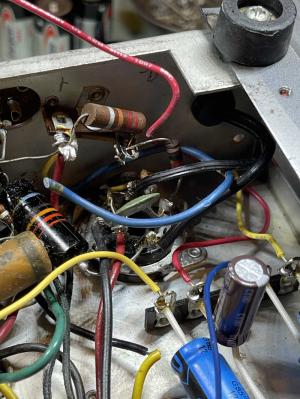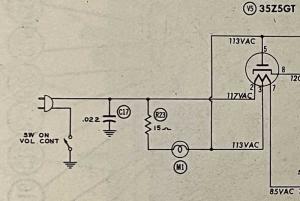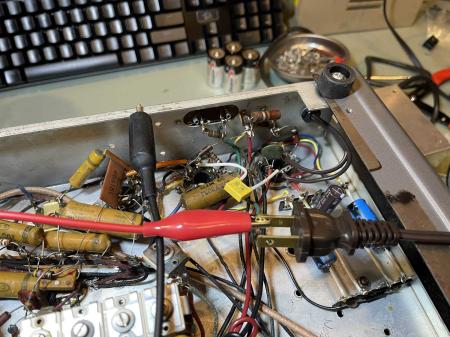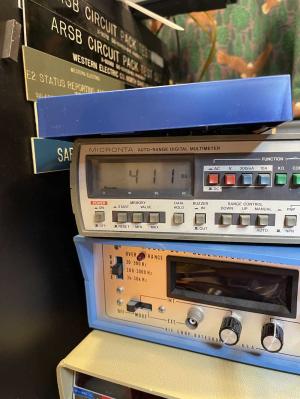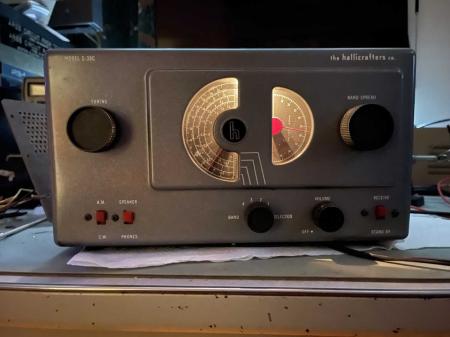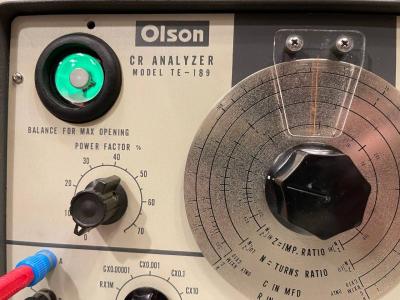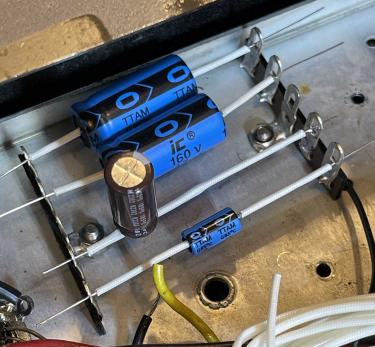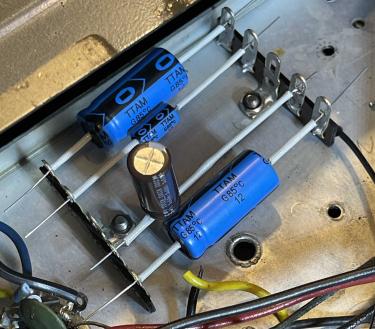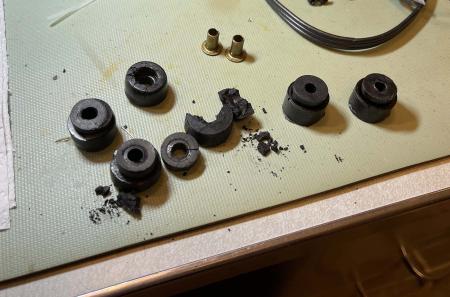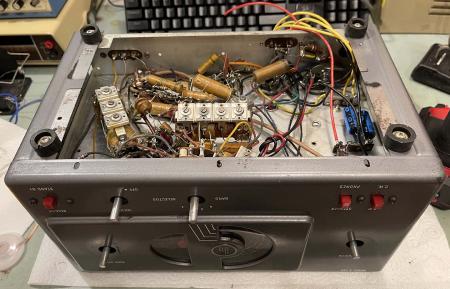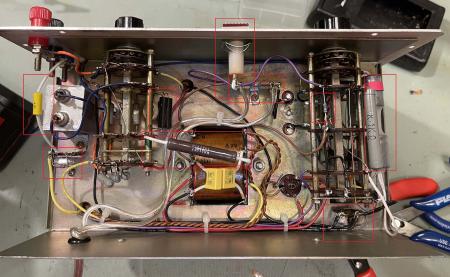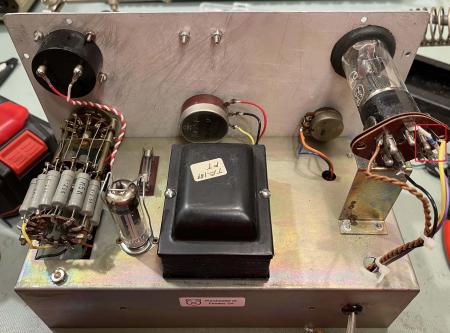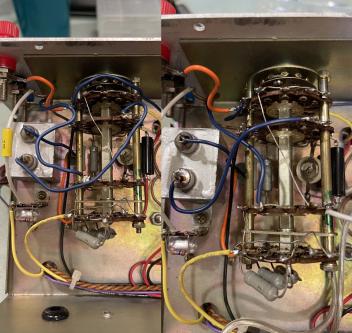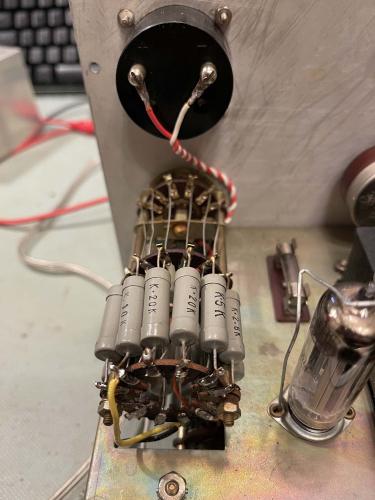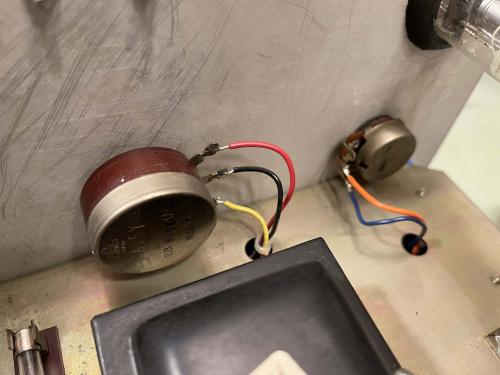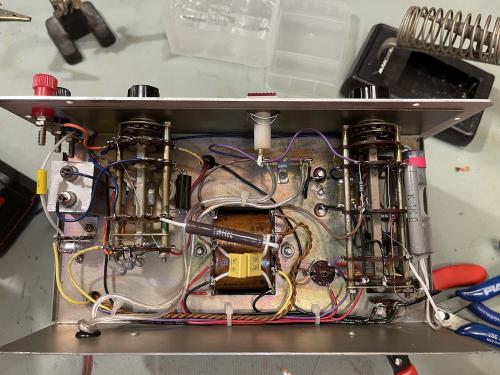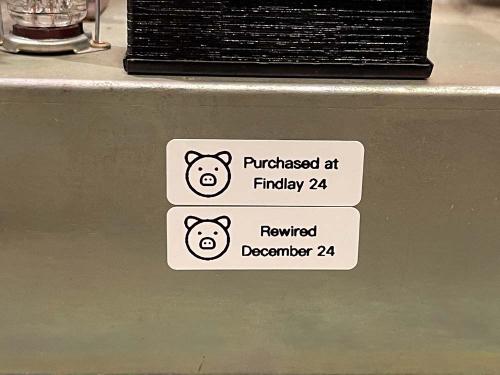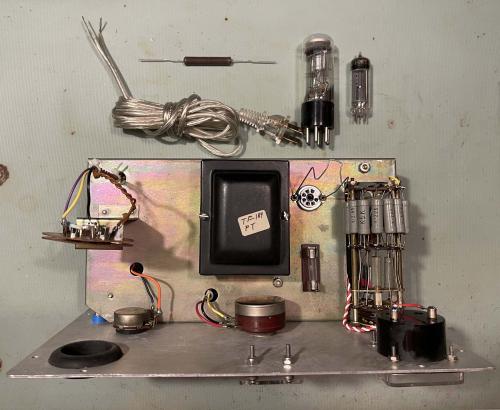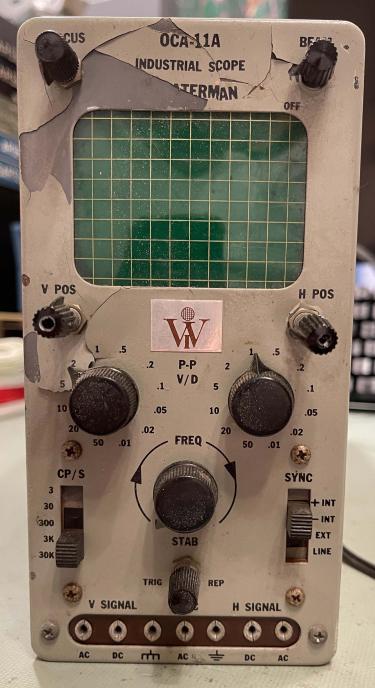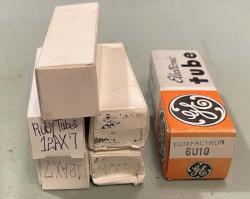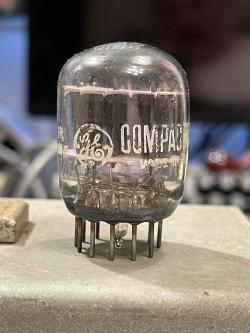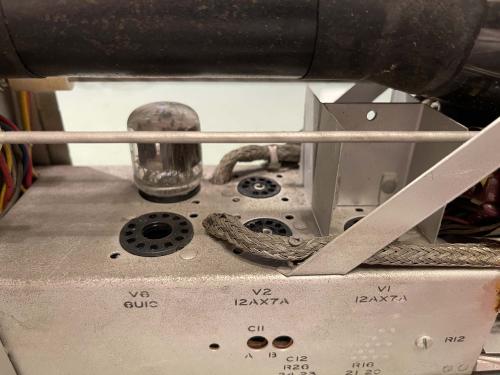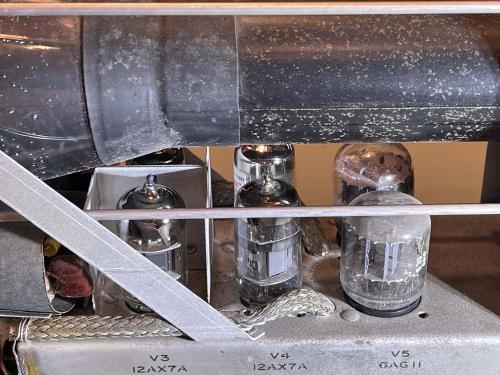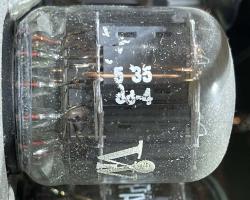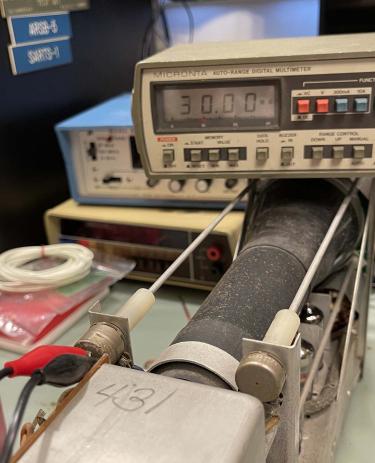- 2025
- Jan
- 2
A Hallicrafters S38-C recap - Wrapup and Bumblebee Capacitors.
I replaced the across-the-line capacitor in this unit with a brand new safety capacitor meant to go across the line. This replaces one of those old multi-color stripe “Bumblebee” capacitors, or bumblebombs as they can be called.
You’ll know these old capacitors because they have a small metal tube on one end with the lead soldered in - for injecting the oil, from what I’ve read. It will also (most likely) be coated with oil. There were other kinds made in this case, like mylar units - but they’re old. Replace it with a modern device actually designed to do the job it’s in place for.
What’s so important about this across the line capacitor that I had to replace it with the filters?
It helps remove noise from the incoming line so it doesn’t get into your radio. But it’s also a part that’s stressed quite a bit as you’re putting AC on what’s essentially a capacitor rated for a DC voltage.
This type of capacitor is an oil-impregnated paper and foil capacitor sealed inside of a plastic shell. While fine for it’s time, the shell cracks and lets oil out, and moisture in. Moisture is bad for a capacitor because water conducts and you don’t want your capacitors conducting. Oil covering the outer shell of this device means it’s been leaking for quite some time.
Let’s check it.
I started by adding new leads (bumblebees have one end that is just a wire soldered into a tube) and shoving it into my B&K capacitor checker. I didn’t feel that the big HP LCR meter was worth getting out for this.
It checks….eh. Yeah, that’s what I’d expect. This thing was likely 20% tolerance, but was probably more like plus whatever minus yeah sure tolerance. But mostly 20%.
This is a good test for my new (old) toy, the Olson TE-189 capacitor analyzer. Testing it, the eye opens nice and wide. The dial indicates about what the B&K meter reads, so we’re right on.
The biggest thing here, however, is leakage.
Yep, 0.2mA of leakage at 150VDC. There should be none that low. This thing is bad bad bad bad bad. At higher peak-peak voltages, this could leak enough to get hot and blow itself apart, or even leak current through something conductive like YOU.
Am I going to toss it? Nope, it’s now a test device. I’ll stick it in it’s own little box where it can leak oil happily until the end of time.
That wraps up the Hallicrafters S-38C Run 4 recap. All of the parts of this series:
A Hallicrafters S38-C recap - Wrapup and Bumblebee Capacitors. - You’re reading it now!
A Hallicrafters S38-C recap - part 4: Doing the work.
https://wereboar.com … rt-4-doing-the-work/
A Hallicrafters S38-C recap - part 3: Layout considerations.
https://wereboar.com … yout-considerations/
A Hallicrafters S38-C recap - part 2: Getting back on it’s feet…
https://wereboar.com … ng-back-on-its-feet/
A Hallicrafters S38-C recap.
https://wereboar.com … rafters-s38-c-recap/
Next up on the bench is an unusual piece of equipment that was obsolete almost when it was new. Stay tuned!
- 2025
- Jan
- 2
A Hallicrafters S38-C recap - part 4: Doing the work.
After laying in the capacitors and forming their leads, it’s time to route and solder wires. The 80W iron has to make an appearance here, as the big terminals are coated with excess solder and excess lead length - quite a bit of wick was used in getting things clean.
When it came time to install the across-the-line capacitor and line cord, I did a couple of checks to make sure I understood which side was chassis and which side was not - at that point I discovered something interesting.
Normally, these were hot chassis units, meaning that one side of the chassis was connected directly to the line cord. This one, however, was not. As shown by the schematic, these radios normally switch ground, which should be neutral in order to prevent your chassis from being 120VAC. This one, however, has about ~411k to chassis…
That’s interesting. This is a Run 4 unit, and my schematic is a Run 2 - it’s possible something changed in the process of making these, and Sams never updated the schematics. Regardless, the remaining components were installed and checked.
The unit lives - after replacement of it’s pilot lamp, that is. As expected, it’s pretty noisy, most likely due to the parts breaking down - all those old capacitors need changed. However, it speaks, and the first thing it says after years of silence is an ad about asking your doctor if this medication is right for you.
Sorry about that, radio.
There’s not really much on the air to listen to on these guys, so I’ll probably clean it up and set it on the display shelf for now, with a full recap to happen sometime in the distant future.
That concludes the recap, but I have one more post to make about this device, and the importance of replacing the across the line capacitor at the same time as the filters, even if it’s not presenting as “bad.” Stay tuned!
Next part of this series: https://wereboar.com … umblebee-capacitors/
Previous part of this series: https://wereboar.com … yout-considerations/
- 2024
- Dec
- 31
More thoughts on the Olson TE-189
I’ve been combing though all of the links about this device and it’s cousin the Lafayette TE-46A, and ran across a couple of videos from 2 years ago.
On a youtube channel called AllTheGearNoIdea, two videos regarding the unit were published. The presenter talks about the device and some of the things done to it in the name of making an older device stable for modern use:
Lafayette Capacitor Analyzer TE-46 part 1: https://www.youtube. … /watch?v=QPL_4AgqTmc
Lafayette Capacitor Analyzer TE-46 part 2: https://www.youtube. … /watch?v=Wzdc7Ai9OnM
In the second video, the presenter tests the newly re-capped unit. He runs through some of the ranges just like I did, only to find they did not work as expected. He was using modern capacitors as well, so I wonder if that has something to do with the problem.
While I don’t have any old paper capacitors at the moment, a piece of equipment on my to-bench list has several it will happily donate.
There was also a link presented that had a much better schematic than the original - it’s at least intelligible instead of “Hey Bob, can you draw me a schematic? This goes into production in an hour!” schematic that Lafayette/Olson presented for the device.
GMB’s Vintage Technology Web Site:
Lafayette CR Analyzer TE-46: http://air-ministry.uk/TE46.htm
Archive of the same page: https://archive.ph/GfeR7
Another archive of the page: https://web.archive. … ministry.uk/TE46.htm
I’ve reached out to the youtube channel page contact. I’ll post more if they reply with something interesting. Stay tuned! (Feb 28 2025: They have not responded.)
- 2024
- Dec
- 30
A Hallicrafters S38-C recap - part 3: Layout considerations.
The original capacitor for this unit was a multi-unit paper tube, and I’m not going to dig the potting out of it to see if I can fit new parts inside. That’s just not going to work, and I don’t care about “looking original.” I decided to use the time-tested method of some solder lug strips and discrete capacitors.
After removing the other one I put in there (and made a mistake with) I settled on these 5 lug strips - one for each capacitor. Since the chassis is hot, I ignored the center terminal and grounded the 4 outer terminals on the back lug. The front lug will be the actual connection points to the individual capacitors.
The only real consideration here is where to place the parts. I thought about doing it this way first:
but the two big 47s push on one another. I decided this:
was probably better, as the circuit doesn’t care about where they are, just that they are electrically connected to the right point. It gives everything plenty of space.
Next step is to form and solder, then run the connection wires. Still waiting on that blue wire!
Next part of this series: https://wereboar.com … rt-4-doing-the-work/
Previous part of this series: https://wereboar.com … ng-back-on-its-feet/
- 2024
- Dec
- 28
A Hallicrafters S38-C recap - part 2: Getting back on it’s feet…
This guy has sat around long enough, and I finally have new feet for it. Since this is a hot chassis radio, it’s imperative that the feet be installed, as they both provide insulation from the chassis, as well as support for the radio.
The feet themselves (and a new knob) came from Renovated Radios http://renovatedradi … duct.php?product=436 - they’re of pretty good quality, and once installed I doubt you could tell them from the old unless you were The Hallicrafters Guy.
The feet only come with the feet themselves, so you need to punch out the old brass bushings and keep all the hardware. Since I had all 4 feet still, I did that - and the old ones just crumbled to pieces.
New on the right, old on the left. There’s nothing left of the old ones, so they go in the trash.
Installing them is relatively easy. They slide into case slots, and screw into the chassis for the back, and just lock down with screws in the front. That, and the front panel screws, and we’re ready to go.
Next is to do what I set out to do - replace the filters. I need to fix the mistake I made last time, and get the new ones wired in. But, what about all those paper caps, you say. I’m not recapping this thing for daily driver use - there’s simply nothing to listen to and I have a nice long distance AM radio sitting beside me as I type this. This is just to make the thing play.
Stay tuned for the replacement.
Next part of this series: https://wereboar.com … yout-considerations/
Previous part of this series: https://wereboar.com … rafters-s38-c-recap/
- 2024
- Dec
- 28
An Olson TE-189 C-R Analyzer - Does it work, and final thoughts.
Before I bolted the device back together, I did some quick checks on the unit. B+ is around 600V, no sparks, smoke, or other problems to note visually, the case isn’t live - we’re good to go.
So. Does it work? Well, yes - for a given value of work.
What does that mean? The device seems to work best for capacitors that were commonly being tested when this thing was new. Electrolytics are fine. Mica? No problem. Big old paper foil? Yep, we’re good.
Modern film? Barely. Ceramic? Don’t even try. These devices weren’t designed to test this type of part, and you won’t get any useful results. Some older devices, especially those from Heathkit, actually stated the types of acceptable parts on the front panel and it’s just the three I’ve listed above.
So it’s not really going to replace the $25 component tester you have in your drawer. But it is great for testing those big old electrolytics, and seems to be decently accurate. It’s fine for resistors as well, and again - seems decently accurate. As accurate as a dial and a subjective “eye open” measurement can be.
I didn’t bother getting a new handle strap for it. It’s going to sit under the signal generator, so no handle is fine.
And here’s a bad shot of it testing an old dry electrolytic rated at 50μF - but actually reading 68μF on my good B&K capacitor checker. The dial is about 65ish, and the eye is open. Yep, that’s pretty good for an analog device with resistors that drifted farther out than the asteroid belt.
I’ve played with some other functions, but don’t necessarily know how to use all of them. I need to read the “manual” ha ha and see how to make it all work.
And the schematic diagram for the unit, as good as it is:
These all came from the Dr. Zee workshop page. I did try to contact this person in regards to the information and their rebuild of said device, but never received a reply. I chose to believe my message wound up in spam and the person didn’t see it - but if you’re that person and you want these links removed, please contact me on mastodon.
The Dr. Zee Workshop page: https://www.mzentert … 89_cr_analyzers.html
Several places sourced parts for this rebuild, including:
Mike’s Obsolete Auto Parts (eBay) https://www.ebay.com … kesobsoleteautoparts
Remington Wire and Materials (eBay) https://www.ebay.com … ustrieswindingsupply
Science Purchase (eBay) https://www.ebay.com/str/sciencepurchase
Surplus Sales of Nebraska https://www.surplussales.com/
Just Radios https://www.justradios.com/
Mike’s had the neon panel lamps, a lucky chance find. Remington and Science Purchase both sell good quality solid wire, Surplus Sales has all kind of terminal strips, and Just Radios sells all kinds of oddball capacitors and resistors useful in old radio and equipment repair.
Final thoughts.
While there really wasn’t much wrong with this device other than the typical stuff you’ll find in an old Japanese device, it’s a prime example of why you do not buy stuff like this sight unseen. This thing was built so poorly that it’s really amazing it even worked. It’s also interesting because I can’t find any mention of these devices being kits - the Olson 1968 catalog says “Factory Wired”:
(That’s $400 today, BTW…)
How did this thing get in such bad shape? I can’t answer that - all of the parts I removed were period correct, so it wasn’t like it had been modified over the years. Couple that with there should be some mention of an assembly manual out there somewhere, but there isn’t.
That’s why you can’t buy something like this without seeing it first. You would be perfectly reasonable to assume this was wired by a competent person in a Japanese factory. I hope it wasn’t for their sake!
Beyond that, it was basically a 1960s Japanese era device rebuild. All of those oil-paper capacitors had to go, and most were replaced with modern equivalents, even if they weren’t exactly the same value. The only one I tried to keep exact was a capacitor in the measurement circuit, and that was made from two in parallel. Others, like the filter, were made from multiple parts as well, and that’s fine. Everything else was wiring and touching up joints.
This device’s condition will forever be a mystery. But then again, buyer beware! Check before you buy.
The complete series on rebuilding this device:
An Olson TE-189 C-R Analyzer - Does it work, and final thoughts. - You’re reading it now!
An Olson TE-189 C-R Analyzer - Rebuild, part 4 - What actually was replaced?
https://wereboar.com … tually-was-replaced/
An Olson TE-189 C-R Analyzer - Rebuild, part 3 - finishing up with parts and wires.
https://wereboar.com … ith-parts-and-wires/
An Olson TE-189 C-R Analyzer - The Waiting Game
https://wereboar.com … er-the-waiting-game/
An Olson TE-189 C-R Analyzer - Rebuild, part 2 - I only wanted to replace some capacitors. https://wereboar.com … ace-some-capacitors/
An Olson TE-189 C-R Analyzer - Intermission: Parts
https://wereboar.com … -intermission-parts/
An Olson TE-189 C-R Analyzer - Rebuild, part 1.
https://wereboar.com … yzer-rebuild-part-1/
An Olson TE-189 C-R Analyzer - Considerations
https://wereboar.com … yzer-considerations/
An Olson TE-189 C-R Analyzer - Some notes on parts.
https://wereboar.com … some-notes-on-parts/
An Olson TE-198 C-R Analyzer Part 2 - What should we replace
https://wereboar.com … t-should-we-replace/
An Olson TE-198 C-R Analyzer
https://wereboar.com … te-198-c-r-analyzer/
Next up will probably be some ramblings about a Heathkit AF-1, and finishing up the Hallicrafters S-38C. Stay tuned!
Previous part of this series: https://wereboar.com … tually-was-replaced/
- 2024
- Dec
- 27
An Olson TE-189 C-R Analyzer - Rebuild, part 4 - What actually was replaced?
When I started this project, it was going to be a replace some caps and move on. Well…the unit was such a basket case that it needed a lot more love. So what was replaced?
Almost all of the coated wire. I tried to keep the original colors, even though they meant nothing for the most part.
The power cord.
(from left to right)
The input blocking capacitor
The bypass capacitor and a resistor for the eye tube.
The 0.04μF capacitor in the measurement circuit.
The 500Ω balancing resistor,
The two across-the-line capacitors on the transformer.
The neon panel lamp.
The neon panel lamp resistor.
The main DC filter.
The filter capacitor was an unusual 5μF @ 700VDC capacitor. I made one from two 10μF @ 450 units, enclosed in a piece of heat shrink. A red band was placed to indicate positive. I think it turned out ok.
The only thing on the top that was replaced (other than wire) is a resistor for the eye tube, mounted directly on the socket.
Miscellaneous:
Knobs, most of them were stripped out.
Screws for the pointer because they snapped when I took it off for cleaning. I used #4 flathead screws here. They sit slightly lower in the pointer than the originals, which were the size of whatever Olson had on hand at the time.
Screws for the face because they were all missing. I assume these were also some odd size because M2.5 was slightly too small and M3 was slightly too large. I ended up going with M3 and just giving it a little elbow grease.
Screws for the back - no idea what these were, I just found something that worked. I think what I used was duplex screws. Who knows, they were in my parts bin and worked-ish.
Next up: Does it work?
Next part of this series: https://wereboar.com … -and-final-thoughts/
Previous part of this series: https://wereboar.com … ith-parts-and-wires/
- 2024
- Dec
- 27
An Olson TE-189 C-R Analyzer - Rebuild, part 3 - finishing up with parts and wires.
This unit has been one of the more interesting devices I’ve picked up at a show. It’s not age related problems, it’s poor build quality from the get go. I think I’ve said it before, but I wonder how this thing got in such a bad state - were these even sold as kits? All of the screws were coated with some odd loctite material, so it appears to have come at least partially assembled…
Regardless, after waiting for the correct wire, I got started again. The wire went on quite the adventure, from Illinois to Ohio, where it visited some suburbs of Columbus. It headed out to Kansas City and visited both states that city occupies before heading to Indianapolis, and finally back to Columbus where it didn’t get delivered. I actually ordered some more wire and got that first - even though the vendor shipped me the wrong gauge! It will still work, however, so onward!
The last portion that really needed rewiring was around the input area:
I did find out that the terminals in that big capacitor are just sitting in little solder pots, so I took the opportunity to clean up a blobby one.
Along the way, I did the meter wiring:
and the potentiometers:
And that’s it. We’re left with a cleaner looking chassis:
and all that’s left is to apply the labels.
A little bit of discussion on what was replaced in the next part, and then for the test. Stay tuned!
Next part of this series: https://wereboar.com … tually-was-replaced/
Previous part of this series: https://wereboar.com … r-the-waiting-game//
- 2024
- Dec
- 15
An Olson TE-189 C-R Analyzer - The Waiting Game.
I was hoping to present a test and performance post for you by now, but the post office isn’t cooperating with me. I ordered some various colors of wire to finish the rebuild (and have some on hand for later use,) but the materials I ordered have decided to take a tour of a few states, as well as the East side of Columbus. It’s visited a couple of places that it had no reason to go. Tonight I got notification that it’s in Kansas. (It went to Kansas again, floating around Kansas City’s two states…I’m going to wait until after Christmas and if it’s not here consider it lost.)
(It made it back to Columbus, then to the city where I work…and then vanished. I ordered a short piece to continue the project, the company I bought the wire from eventually considered it lost and replaced it all. I then received the original package in March 2025 - but the post office doesn’t know how, why, or even where it is right now!)
For now, I have the line cord and the 500Ω balancing resistor laid out alongside the tubes. They await the final wire I need for this build.
I have some time off over the holiday, so perhaps I’ll have received it by then. We’ll see - stay tuned!
Next part of this series: https://wereboar.com … ith-parts-and-wires/
Previous part of this series: https://wereboar.com … ace-some-capacitors/
- 2024
- Dec
- 15
A Waterman OCA-11A “industrial / pocket” oscilloscope - Part 2: Tubes!
I picked this device up at the MARC hamfest in North Canton. The seller stated “Someone removed all the tubes except one” and he was right. 4 12AX7 and 1 6U10 were required to fill all of the sockets again.
This is the device in question. It looks like it requires both a horizontal and vertical input, but I’m not sure.
Thanks to Bob @ hamtubes.com, I was able to acquire the necessary tubes. I’m not sure why they were removed, they aren’t really that much unless you want old RCA branded 12AX7. The 6U10 compactron isn’t expensive at all. I chose Russian and Chinese 12AX7 because this is an instrument, not an amplifier.
A little bit about one of these tubes: the 6U10 “”compactron” was the last gasp of the tube industry. Packing up to 4 devices in a single shell, this was an attempt by GE to reduce the number of tubes required for a television set. Had these come out before the transistor era started, we might have seen more elements in a single tube, but we didn’t, and the rest is history. This particular device contains 3 triodes - probably why it was removed by the previous owner.
So let’s open it up and populate things. Indeed, it is empty in here:
And now it’s full:
Some of these tubes were hard to get in to their respective sockets.
I did notice the one remaining tube was Waterman branded. That’s too bad, the others probably were too. I wonder who made these - maybe I’ll pull it out sometime and see if it has an EIA code on it.
Ok, so…let’s try it. Checking across the line cord I get…nothing. Mmmmm that’s not good. No external fuses, so what’s wrong here. Start with the line cord, it goes to the fuse, then to the switch, then to the ….nothing.
Power switch is bad. It’s pretty corroded, so no surprise. Well, I’m out of time for this particular device at the moment, so a note and set it aside. Stay tuned for the next part where we turn it on for reals!
Next part of this series: Coming soon.
Previous part of this series: https://wereboar.com … pocket-oscilloscope/

